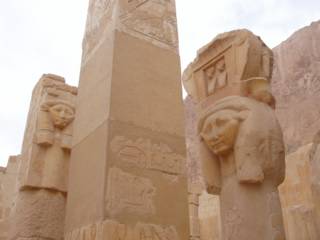
Hathor column, Deir el-Bahri, Hatshepsut's Tomb. ARTIFACT OF THE DAY.
 Hatshepsut's statues could be torn down, her prayers effaced, but the tomb remains, monumental, of stone, and enduring. She lived nearly 4,000 years ago, and ruled as the first female Pharoah for nearly 20 years, first as regent for the young Tuthmosis III, and then on her own. The picture shows columns still standing in a small temple dedicated to Hathor on the left side of the tomb. Other reliefs throughout the tomb show Hatshepsut's accomplishments; she negotiated and fought battles with Nubians, and a monumental frieze documents her expedition to the ancient city-state of Punt (today, Somalia), showing marvelous sea creatures, boats, gifts and giant mounds of incense. The frieze is now very difficult to see, colors worn away by sun and wind. An authorized copy was made of this very large frieze; the museum copy is now sharply incised and more brilliantly painted than the original.
Hatshepsut's statues could be torn down, her prayers effaced, but the tomb remains, monumental, of stone, and enduring. She lived nearly 4,000 years ago, and ruled as the first female Pharoah for nearly 20 years, first as regent for the young Tuthmosis III, and then on her own. The picture shows columns still standing in a small temple dedicated to Hathor on the left side of the tomb. Other reliefs throughout the tomb show Hatshepsut's accomplishments; she negotiated and fought battles with Nubians, and a monumental frieze documents her expedition to the ancient city-state of Punt (today, Somalia), showing marvelous sea creatures, boats, gifts and giant mounds of incense. The frieze is now very difficult to see, colors worn away by sun and wind. An authorized copy was made of this very large frieze; the museum copy is now sharply incised and more brilliantly painted than the original.
Every image I brought back from sabbatical has a different story. If I listen just to the guides and read the printed materials available at site, I get one level. If after coming home, I look at popular articles, I get another level. And if I have good research materials, I get a third level. Hatshepsut is a case in point. We were told on site that the pharoahs after Hatshepsut destroyed and defaced her statues, and worked to erase her name from the list of pharoahs and from all memory because they didn't want to record a female pharoah. The next level of research reveals that indeed, she reigned as pharoah, regent and king for nearly 20 years, but popular stories affirm she was a peaceful ruler (being a woman, of course). The next layer of research reveals that she went on at least two military expeditions as well as the fabled expedition to Punt. And that other women ruled as "kings" and pharoahs of Egypt.
Hathor is typically shown with a female face, full hair, and cow's ears. I like to say Hathor's the original cow girl, but her identities were many and her power was recognized everywhere -- even to Abu Simbel. Hathor, a sky and cow goddess, was considered the Mistress of the West (traditionally the land of the dead, the direction of the dying sun), and placed near tombs or shown offering the ankh, the symbol of life to the pharoah, at once protecting and nurturing the ka or soul of the departed. Many offerings would be brought to Hathor during the Beautiful Feast of the Valley in a magnificent procession. So, Hathor brought hope at the moment of death. I think I'm fascinated by her because Hathor is decidedly female; she looks like someone we might know -- if we could set aside her ears.
No comments:
Post a Comment